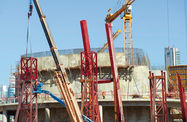The local real estate sector continues to send out mixed messages. While Kuwait’s residential segment is clearly on the rise, other components of the market are struggling to rebound from the downturn in the property market in 2009 and, more recently, domestic political concerns.
In its mid-November briefing on the economy, the National Bank of Kuwait (NBK) said there had been a slight easing in the property market in September. Residential sales were down 1.7% year-on–year (y-o-y), though the bank said at least some of this decrease was due to seasonal effects, with the residential property turnover usually slower immediately after Ramadan. September’s result marks a rare retreat for the residential segment in 2012, as the general trend for most of this year has been a moderate increase in prices and in transactions.
Residential sales have averaged just under $354m per month for the first three quarters of this year, up on the $333m average figure for the opening nine months of 2011. A solid final three months should see the segment well positioned to enter 2013. A potential sales spurt is on the cards after the reserve bank lowered its base discount lending rate in early October to 2%, having already eased lending requirements, allowing more cash to flow into the market.
This has indeed had an impact on the sector, with the Central Bank of Kuwait reporting in mid-November that new bank lending for real estate transactions increased 4.9% y-o-y in September and should be reflected in the October figures, due out in December.
While the residential segment has proved fairly resilient to external factors, the long-running political standoff between the government and parliament has affected the rest of the sector, a situation that could continue into 2013. Uncertainty over the make-up of the new parliament following national elections in December may have an impact on the real estate market, as any stalemate in the new legislature will result in further delays in approving government plans for property and infrastructure developments.
The recently dissolved legislature was at odds with the government over a number of its major projects, demanding greater accountability from parliament and querying some of the government’s $108bn investment programme. This standoff has hindered the rollout of developments while also sapping investor confidence.
That lack of confidence may well be a factor in at least one segment of the property market: office space and other commercial transactions have stalled. According to Tawfiq Al Jarrah, the head of the Kuwait Real Estate Union, the occupancy rate for office space is less than 60%, and there are also many commercial developments that have yet to be finished.
“There is a glut of supply of office space,” Al Jarrah told Reuters in October. “Occupancy is the engine and dynamo of the property market.”
The latest NBK report on the property market said there were only four commercial property sales in September, with a total value of $49m, around $34m down on the same month in 2011. However, the September result was somewhat better than the preceding month, when three deals were sealed for a total sales value of $24.8m.
But with buyers having easier access to funds, Kuwait’s residential property market should maintain steady progress moving into 2013. While the outlook for commercial property and, in particular, the heavily oversupplied office segment seems likely to be contingent, at least in part, on whether the government will be able to encourage greater investment in 2013 and stimulate further growth.

